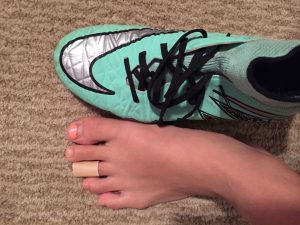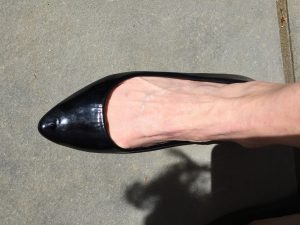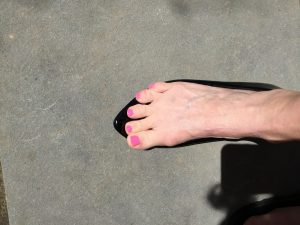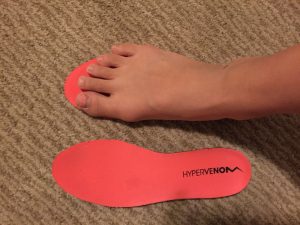In this season of polarized opinions, let’s at least agree on this: Foot binding is bad. Practiced centuries ago in China, the basic idea was to bind young girls’ feet so tightly that they stayed bizarrely small as a display of wealth, beauty and social status. Of course we wouldn’t do that to our children today! Or would we? Read on and consider how your shoe choices might be binding you.
I’m being slightly dramatic to make a point about a recent experience with my own daughter. Anna, 14, plays club soccer, school soccer, and lacrosse. The girl spends a lot of time running around in cleats. And the fashion right now is to have neon colored Nike cleats. Anna wanted a certain pair so much that she paid for them herself. They are way cool. But after a few weeks, she was complaining that her feet and knees were hurting when she ran, so I took a good look at her new cleats. This is what I saw:

As you may be able to tell, Anna’s feet are sort of “triangular”: very narrow at the heel and much wider at the ball and toes. I would describe the cleats as “tubular”: narrow and with a consistent width from heel to toe. In order for Anna to wear those cleats, her forefoot had to seriously deform its shape. And then she spent hours pounding around various fields in them, changing direction, jumping and otherwise adding lots of impact to feet that were squeezed so tightly they could barely function as anything but stumps
So now she wears shoes that are a much better fit (in a very boring black) and her pain has subsided. Problem solved. At least until she decides to participate in that other form of foot binding known as “women’s dress-up shoes”.
If you pay attention to the health media at all, you know that high heels are bad for your whole body—not just your feet. So flats are the answer, right? Well, maybe. I am lucky to have a job that lets me spend my time in super-healthy footwear: sneakers for workouts and minimalist shoes that keep my feet strong and flexible and the rest of my body aligned. But a few times a month I need to dress up a bit, so I reach for ballet flats. Here is the pair I wore last week for about 2 hours of suffering. They look fine in the first photo, right? Can you find the source of my suffering in the second photo?


Are you curious about your own shoes? There are a couple of ways to compare the shape of your actual foot to your shoes. The easiest is to remove the insole, put it on the floor, and stand on it (as Anna shows us, below). See how much your foot might “overflow” the insole. If your insole is not removable, stand on a piece of paper with your weight on that foot and have a friend trace your foot shape with a pen held vertically all the way around. Then put your shoes on the tracing to see how they match up.

Next time, I will share my favorite foot therapy techniques. In the meantime, here’s some fun homework to give you an example of how shoes can deform (bind!) the feet of even the rich and famous. Find the May 2016 issue of Oprah magazine (on newsstands now!) and look at the big toe that is showing in her cover photo. See what you notice and share your observations on my Facebook page.